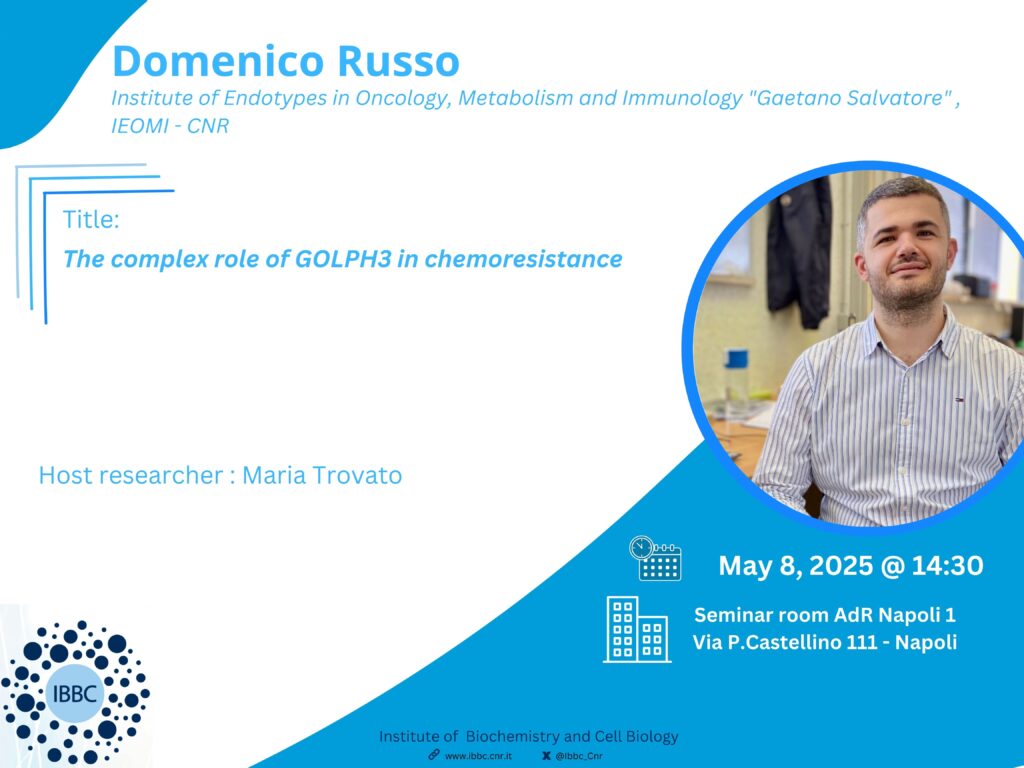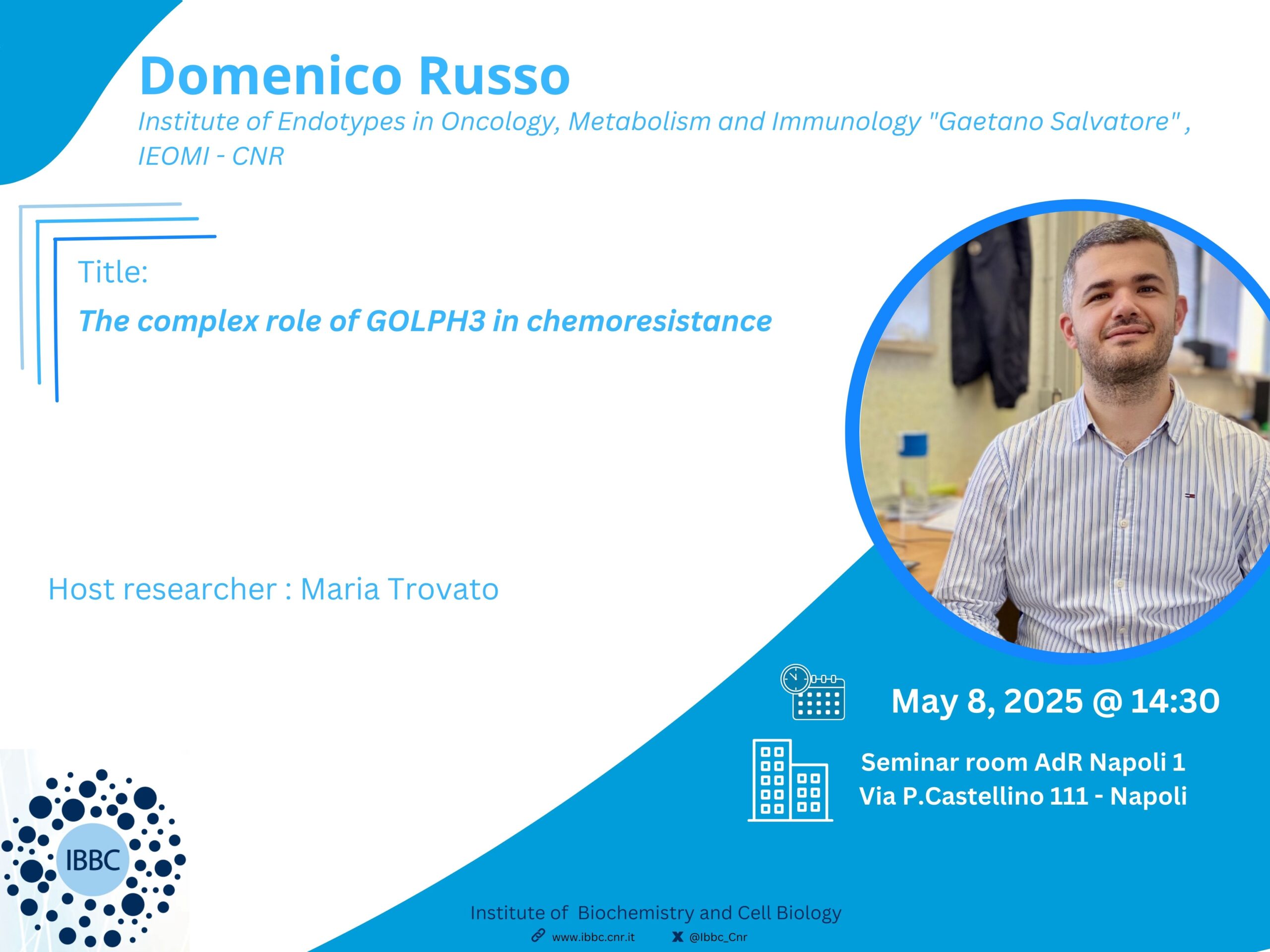- Dr Domenico Russo
Institute of Endotypes in Oncology, Metabolism and Immunology “Gaetano Salvatore” – CNR - Title: “The complex role of GOLPH3 in chemoresistance”
Abstract
Sphingolipids (SLs) encompass various bioactive lipids with roles ranging from cytostatic and proapoptotic to growth-promoting. The intricate balance between these species is crucial for cellular fate determination and stress response, governed by control systems regulating their production and intracellular movement, notably at the trans-Golgi network (TGN), where sphingomyelin production is finely tuned.
Ceramide, a pivotal SL, is ferried from the endoplasmic reticulum (ER) to the TGN via non vesicular transport mediated by CERT. At the TGN, ceramide is converted to sphingomyelin by SMS1, yielding diacylglycerol as a byproduct. Locally produced diacylglycerol activates protein kinase D (PKD), which phosphorylates and deactivates CERT, halting sphingomyelin synthesis. PKD activation also affects phosphoinositide turnover at the TGN, disrupting lipid exchange between the ER and Golgi.
 Consequently, increased ceramide levels inhibit its transport out of the ER, crucial for cell fate as unchecked ceramide promotes cell cycle arrest and apoptosis. Disposal of ER-located ceramide involves conversion to glycosylated derivatives, particularly glycosphingolipids (GSLs), which possess growth-promoting properties. This led to an inquiry into how the ceramide glycosylating machinery reacts to excess sphingolipid flux.
Consequently, increased ceramide levels inhibit its transport out of the ER, crucial for cell fate as unchecked ceramide promotes cell cycle arrest and apoptosis. Disposal of ER-located ceramide involves conversion to glycosylated derivatives, particularly glycosphingolipids (GSLs), which possess growth-promoting properties. This led to an inquiry into how the ceramide glycosylating machinery reacts to excess sphingolipid flux.
The Golgi oncoprotein GOLPH3 functions facilitating retrograde transport of GLSs synthesizing enzymes to the ER, intercepting and disposing of the ceramide pool. Our findings demonstrate that the sphingolipid overload activates PKD which culminates in GOLPH3 phosphorylation on Ser124 amino acid residue. Gene copy number variation and protein overexpression of GOLPH3 in several solid tumors underline the crucial role of GOLPH3 phosphorylation in preventing apoptosis triggered by ceramide accumulation. Given that the anti-cancer treatment approaches like Chemotherapy/Radiotherapy aim to accumulate ceramide, GOLPH3 amplification could not only make ineffective the attempt at ceramide-induced apoptosis, and chemoresistance phenomenon, but could represent fuel for the continuous production of GSLs which contributes to activate survival/proliferation pathways in tumor cells.
By combining biochemistry, live cell imaging (2D and 3D), and OMIC tools we are shedding light on the molecular basis of the chemoresistance in tumors with altered genetic background of GOLPH3 to prove how GOLPH3 could represent a valid pharmacological target
Biosketch – Domenico Russo
Domenico Russo began his scientific journey in the field of immunology, where he conducted pioneering experiments on novel vaccine formulations using filamentous bacteriophage. These studies were carried out at the Institute of Protein Biochemistry (IBP) during his undergraduate thesis at the University of Naples Federico II, in the laboratories of Dr. De Berardinis and Dr. Rossella Sartorius. He earned his Ph.D. in 2014 under the mentorship of Dr. Giovanni D’Angelo, with whom he co-authored a seminal publication revealing a novel role for glycosphingolipid (GSL) metabolism in the regulation of cellular differentiation programs. This work laid the foundation for his long-standing interest in membrane biology and lipid-mediated signaling pathways. In 2018, he joined the research group of Dr. Alberto Luini, where he further explored the dynamics of GSL-metabolizing enzymes within the Golgi apparatus. Together, they published important findings on how these enzymes are spatially and functionally regulated by the Golgi-associated protein GOLPH3, both under physiological conditions and in cancer. This line of research opened new perspectives on the interplay between membrane trafficking and oncogenic signaling, a topic he continues to explore. Since 2021, Domenico Russo has held the position of Research Scientist at the Institute of Experimental Endocrinology and Oncology (IEOS). In 2023, he established his own independent research group focused on the organization and regulation of glycosyltransferases within the Golgi during differentiation and in disease contexts. His broader research interests also encompass Golgi membrane trafficking and the mechanisms by which organelle architecture contributes to cellular homeostasis. Domenico is actively involved in the activities of the EuBi imaging facility, where he applies his solid expertise in advanced microscopy techniques—an expertise he has built over the years through both training and practical application. He is committed to advancing our understanding of the secretory pathway and its implications in development and pathology, and his work aims to unravel how membrane trafficking pathways are rewired in response to physiological and pathological cues.

